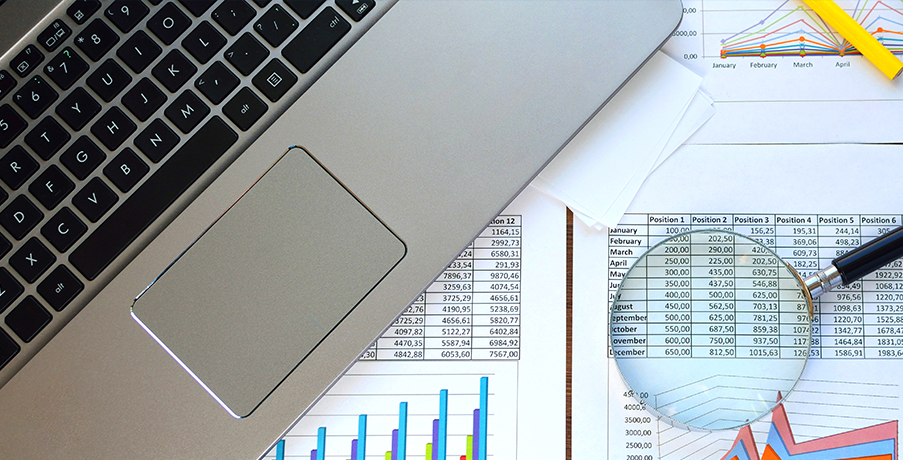sales
How to Create a Monthly Sales Forecast
You wouldn’t head out to the beach without checking the weather forecast before you left the house, would you?
Then why would you try to run a business without forecasting your sales?
Sales forecasting is one of those areas a lot of businesses struggle with – they simply look at the past year’s numbers, tack on an arbitrary percentage, and hope for the best.
There is no shortage of benefits to forecasting monthly sales. Some of the highlights include:
Better Decision Making
If you have an idea of how your month, quarter, or year is going to play out, it’s much easier to make decisions about both the immediate future of your business and the big picture beyond.
If projections look rosy, it might be time to consider expanding, to hire more people, or to start developing new products or services.
If the forecast doesn’t look so good, you may consider downsizing (or at least holding off on big expenditures), consolidating your business, or simply lowering your costs.
The point is, knowing how your business is going to perform, even if it’s just a prediction, helps you better navigate the waters ahead.
Helps Procure Loans and Investors
If you’re looking for outside capital for your business – whether in the form of loans or investors – odds are they’re going to want to see your sales forecasts before committing to giving you money.
The sales forecast shows investors where you are, and where you’re headed.
Helps Create Budgets
Your business has to operate within a budget – and if you have no idea what your revenue and expenses are then that becomes more challenging. Having a sales forecast shows you how much revenue you expect to have coming in, which makes creating a budget much simpler.
Shows Sales Pipeline Health
Your sales pipeline is vitally important to your business, and a sales forecast will require evaluating all of the business in your pipeline and projecting what’s to come. This is invaluable because it allows you see where there are potential bottlenecks in your pipeline today, giving you an opportunity to fix them before they become really detrimental.
Reduced Risk
Another way utilizing a sales forecast can help your business is by allowing you to reduce risk.
We talked about some of this above – having a reliable estimate of sales and income will help you make better-informed decisions, but it goes further than that.
A sales forecast can reduce risk. An accurate sales forecast will spot weakness and deficiencies in revenue – allowing you to repair or adjust for them them and reduce your risk before these issues become an actual problem.
Realistic Quotas
If you have no idea how many sales you expect to generate, how can you hope to create realistic and attainable quotas for your team? The simple answer is you can’t.
Studies show that roughly 66% of sales people aren’t hitting their quotas. Does this mean that they’re all lazy slackers? Does this mean we’re terrible at hiring sales people? In some cases, maybe – but the bigger issue is the quotas themselves.
Far too often, companies make quotas based on taking old numbers and increasing them by a few percentage points. That’s a recipe for disaster. Even the most successful companies have peaks and valleys along their revenue timelines, so assuming revenue will go up 5% every year and setting quotas accordingly is a roadmap to disappointment. It gets even worse if you have an unexpected down year. No wonder sales people miss their marks…
Having an accurate sales forecast makes setting quotas easier – you have a real idea of how much revenue you’ll earn, not a gut feeling. Armed with that knowledge, you can set realistic, attainable goals for your sales team.
At any rate, these are just a few of the reasons why you should be sales forecasting. There are more – so now’s the time to start thinking about how to implement forecasting into your planning if you aren’t already.
How to Create a Monthly Sales Forecast
Now that we know why you should be using a sales forecast, let’s talk about how to create a monthly forecast that will help you gain new insight into how your business is working.
Creating a monthly forecast is really no different than creating a quarterly or yearly forecast. You’ll use the same methodology, you’ll just be changing the timeframe.
The great news here is that sales enablement software can make this process both simple and eerily accurate.
One of the common complaints against forecasting is that it’s still just a prediction…and predictions can be wrong. However, with modern software using complex Artificial Intelligence and algorithms to break down huge amounts of data, the art of forecasting has become a lot more accurate.
So, while you may start with a simple historical forecasting method, you really should consider the technological solutions on the market to take your forecasting to the next level.
That being said, if you’re looking to make a monthly sales forecast using Excel or another spreadsheet, that’s an acceptable alternative too.
Here are the things we need to consider in our 12-month sales forecast:
Determine what goods and services you’re offering
We start at the obvious place – what products or services will you have available for purchase during the period your forecast will predict. It seems obvious, but seasonal fluctuations have to be taken into account – not only in terms of customer behavior, but in your product offerings.
Estimate the number of each item you will sell
Now that we know what we’re selling it’s time to start thinking about how many of them we anticipate selling during the time period covered by the forecast.
There are a number of different ways to arrive at this number – from simply making a prediction based on historical data to qualitative and quantitative approaches. The point at this stage is to simply figure out what you expect to sell. Whichever method you use to arrive at that number is up to you.
Determine your cost on each good or service you sell
To be truly accurate, we need to not only know what we’re selling, how many units we anticipate selling, and the price of those units…we need to know the cost too.
Do the Math
Now that we know what we’re selling and how much we’re selling it for, we can subtract the total amount of the cost for the items you intend to sell from the total amount you will make from the sales.
The number you wind up with provides a very simplistic estimate of revenue for your company. Ta da! It’s your first sales forecast!

Top Down or Bottom Up: Which Forecast is Better?
Now that we’ve talked about the basics of creating a sales forecast, let’s dig a little deeper.
While you can really go down a rabbit hole with sales forecasting methodologies (and if you’d like to take a deeper dive, this article is a good starting point), at the highest level there are essentially two ways to forecast: top down or bottom up.
The top down approach is one that lures in a lot of unsuspecting businesses because it feels so simple and the results you get feel realistic.
In the top down approach, you’d look at the entire market value of your industry. Say you were a car manufacturer – and there are $10 billion dollars worth of cars sold per month in the country.
With the top down view, you’d simply say “all right, there’s $10 billion in money out there, and we should be able to get 5% of that money based on previous performance and what we hope will happen this year.”
That number might seem reasonable. Here’s the problem – it only has a passing relationship with reality.
In our example, the top down method is at least a little bit viable because we can use historical data (we captured nearly 5% of the total market for the last period), but again – it doesn’t take anything into consideration beyond that historical data. There’s no consideration of market fluctuations and corrections, no consideration of how the industry might be affected by external forces (new products, new regulations, etc.), and so on.
The danger of the top down approach is it seems realistic…but its conclusions don’t generally draw on enough real data to be anything more than wishful thinking.
Bottom up forecasting flips this all around and works in the opposite direction.
In this method you focus on a target market — and then figure out how many people in that target market you can reach through your marketing and promotional channels.
As a simple example, here’s a breakdown:
- 100,000 people see your online ad
- 10,000 people come to your site from the ad
- 1,000 people make a purchase
From here, it’s just simple math to multiply that 1,000 by what you think the average customer will spend. You probably already know what your average spend is per customer from the previous period – so once you consider seasonal fluctuations and the like, you can plug that in and get a projection.
There’s guesswork involved in this method too – however, if you actually look at your historical data and talk to customers, you can get a pretty good idea of what the average spend will be.
Keep in mind, these are high level sales forecast approaches – whether you choose top down or bottom up, it’s really just the tip of the forecasting iceberg. As you’ll see in the article we linked earlier, there are a lot of additional methods to use create your most detailed forecast. From 12 month sales forecast templates to cutting edge sales enablement software, there’s no one right or wrong way to forecast sales.
Final Thoughts
When it comes to how to forecast monthly sales, the method you use is of less importance than the fact that you’re actually taking the time to forecast sales.
Many sales teams and companies are intimidated by monthly sales forecasting because it feels like a lot of work. Getting set up can require some research and some math skills for sure, but the rewards far outweigh the effort.
Creating a detailed sales forecast can help you take your team to the next level – so don’t be put off. Start implementing a forecasting program today and see how you can take your business to new heights.
Want to learn more about sales and marketing? Then be sure to subscribe to our blog so you don’t miss our latest posts!
Accent Technologies is the first and only SaaS company to bring together Sales AI and Content Management in a true Revenue Enablement Platform. We provide both sales and marketing with better visibility into the performance of their teams. This drives revenue through intelligent recommendations for complex sales scenarios and provides the data for rich analytics that power better coaching, forecasting, and long-term customer support. Learn more about our solutions or request a live demo to see it in action.
By Accent Technologies
5th November 2020
Sales Calls Tips the Accent Way
Executing effective persona-targeted messaging, sales plays, and follow ups can be extremely difficult in a complex B2B sales situation. Especially, if you’re basing your game plan on subjective assumptions about the opportunity’s health, intent, and key influencers.
But what if you could KNOW for certain who your engaged personas are? What if you could confirm their level of influence on the purchasing decision, and see how they reacted to each activity your sellers conduct with them?
With that level of insight, you could build an iron-clad sales effectiveness analysis, and dramatically improve execution of your sales team.











